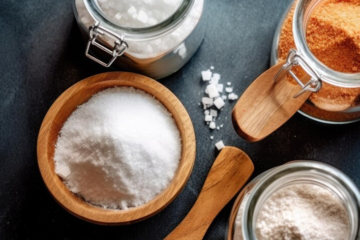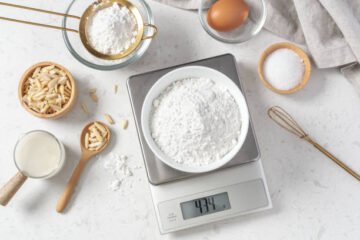Cooking is not just about throwing food ingredients into a pot and hoping for the best. It requires precision and accuracy, especially when it comes to measuring cooking ingredients. The right measurement techniques can make all the difference between a successful dish and a complete disaster. After all, accurate measurement of your ingredients is one of the keys to delicious cooking and mastering the art of proper cooking technique itself.
In this blog, I will explore the importance of accurate measurement techniques like baking soda and provide some tips to help you master them.
Why Proper Ingredient Measurement Techniques Matter
Nobody likes their food tasteless, too thin, too thick, too sour, or too spicy. Simply put, everyone loves to have a balance of taste, texture, and flavors. But that’s not all. Here are some reasons why accurate food ingredient measurement is crucial:
1. Ensures Consistency Every Time You Cook:
When you measure your cooking ingredients correctly, you can reproduce your recipes with the same results every time. This is especially important if you are cooking for others, as they will expect the same taste and texture every time they try your dish.
2. Perfect Flavor:
Accurate measurement of ingredients ensures that your dish tastes as it should. Too much or too little of an ingredient can drastically change the flavor and texture of a dish. For example, if you add too much salt, your dish will be too salty, but if you don’t add enough, it may be blended.
3. Deal Breaker for Baking & Exotic Dishes:
It is easier to fix a recipe that goes wrong in everyday cooking. For instance, if the dish is too salty, you may add lime juice, lemon juice, or apple cider vinegar. Similarly, you can add more spice, red wine vinegar, or lime juice to balance out the sweetness. However, it’s not the same when you are baking or preparing exotic dishes.
Baking is a science, and the accurate measurement of ingredients can make or break a recipe. If you add too much baking powder or too little flour, your cake may not rise correctly, resulting in a dense, unappetizing cake.
Similarly, exotic dishes often require expensive ingredients. Some of these ingredients are exotic and have a very distinct taste. For instance, Dea Harrisa. Furthermore, there are dishes like “Fugu” or “Globefish,” which can be fatal if not prepared correctly. In such cases, one must make judicious use of kitchen scale resources to attain perfection.
Different Food Ingredients Proper Measuring Techniques You Can Use
1. Measuring Spoons:
Have you noticed that some of the ingredients in your recipe are measured using ‘t’ and ‘T’? Well, in such cases, they want you to measure the ingredients using measuring spoons.
Measuring spoons are suitable for measuring both dry and wet food ingredients. These include ingredients like baking soda, baking powder, essences, etc.
These spoons typically come in a set of 5:
- 1/8 teaspoon
- ¼ teaspoon
- ½ teaspoon
- 1 teaspoon
- 1 Tablespoon
Note.: In your recipes, ‘t’ stands for teaspoon and ‘T’ for tablespoon.
And another fun fact? 3 teaspoons are equal to 1 tablespoon.
Now while using a measuring spoon, make sure you level off the top of the spoon with the straight edge of a knife to get the perfect measurement.
2. Dry Measuring Cups:
Dry measuring cups are typically available in plastic or metals. These cups may come in a set of 4, 5, or even 10, depending on the brand you buy them from. But the standard measuring cups are as follows:
- 1 cup
- 1/2 cup
- 1/3 cup
- 1/4 cup
Another thing to keep in mind is to use graduated drying cups. Simply put, these cups typically stack one inside the other.
Now, to measure dry cooking ingredients like flour or sugar, do the following:
- First, stir them in their container.
- Then, dip the cup into the container or use a large spoon to fill it without packing it.
- Next, even off the rim of the cup with the straight edge of the knife.
You will also find the need to measure cooking ingredients that are neither dry nor completely wet. For instance, honey or peanut butter. In such cases, do the following:
- Spray the cup with vegetable spray.
- Fill the cup using a spoon and even off with a knife.
3. Liquid Measuring Cups:
You can measure wet food ingredients in a dry measuring cup. So why do you need a liquid measuring cup? It’s because to measure a wet ingredient, you must fill the dry measuring cup to the brim. And there is a high chance that you may spill while lifting and pouring the cup.
Liquid measuring cups are typically transparent in color with measurements marked on their surface. To use them, all you need to do is place them on a flat surface and fill them with the ingredients slowly until the top surface of the liquid (meniscus) is just at the level you need.
Pro tip? Bend or squat so that your eyes are at level with the markings for accurate measurement. But wait. Some newer cups have a slanted piece on the inside which makes it easier to read the marking from the top.
But what about small quantities?
Use a measuring spoon to get an exact quantity of liquid that’s a tablespoon or less. The right-sized spoon should be filled to the very top without spilling.
4. Digital Weighing Scales:
Digital weighing scales allow for more varied units of measurement. For instance, besides being able to measure in grams and kilograms, you can also measure in pounds. Furthermore, since they use sensors, they are capable of measuring even tiny quantities with absolute accuracy.
All you need to do is switch on the machine, set the right measurement unit, and add the ingredients. You can add more or reduce the quantity based on the readings.
Tips for Accurate Measurement
Now that we understand the importance of proper ingredient measurement and different measuring techniques, let’s look at some tips to help you master them.
1. Read the Recipe:
Before you begin cooking or baking, read the recipe carefully. Check to see if the food ingredients are listed by weight or volume, as this will determine the measurement technique you should use.
2. Use Ingredients at Room Temperature:
When baking, it is essential to use cooking ingredients that are at room temperature. This is because ingredients that are at different temperatures can affect the consistency of your batter or dough, resulting in an uneven bake.
3. Use the Right Measuring Technique:
Different cooking ingredients require different proper measuring techniques. For example, when measuring flour, use a spoon to scoop it into the measuring cup and then level it off with a knife. However, when measuring brown sugar, pack it into the measuring cup and level it off. Similarly, for wet ingredients, use liquid measuring cups. And if you are measuring peanut butter, yoghurt, etc., make sure you use a vegetable spray.
4. Use The Right Tools & Be Consistent:
Consistency is key when it comes to accurate measurement of ingredients. Use the same measuring cups or spoons each time you cook or bake, and make sure to level off the ingredients, in the same way, every time.
5. Don’t Overcrowd Your Measuring Cup:
When measuring dry ingredients, such as flour, it is essential not to overcrowd the measuring cup. This can result in too much flour being added, leading to a dense and dry dish.
Conclusion
Proper ingredient measurement techniques are essential for successful cooking and baking. They ensure consistency in your dishes, help to achieve the right flavor and texture, and are crucial for baking. But remember that different measuring techniques serve different purposes. Thus, it’s important to choose the right technique for accurate measurement.
Furthermore, by reading the recipe, using room temperature ingredients, being consistent, and not overcrowding your measuring cup, you can master the art of ingredient measurement and take your cooking to the next level.
Accurate Meezan offers one of the best ingredient measurement digital kitchen scales. Its built-in high-precision strain gauge sensor system with a large bowl volume (1500 ml) and zero and tare-off function make it easier to measure ingredients accurately.
So why wait? Master the art of ingredient measurement today!

